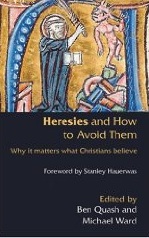
The chp is written by Janet Martin Soskice, a Roman Catholic and Fellow at Jesus College in Cambridge.
She argues that sometimes Trinitarian doctrine and worship are defended on grounds that are of questionable orthodoxy. She goes first to the Johannine Comma, the verse in 1 John 5:7 that says “For there are three that bear record in heaven, the Father, the Word, and the Holy Ghost; and these three are one.” I don’t know about you, but I grew up on the King James and that verse was in my Bible. The text didn’t appear until the 800s in Latin and until the 1200s in Greek. But good ol’ Erasmus somehow produced it for his Greek New Testament and it found its way into the Textus Receptus and therefore into the KJV.
Soskice shows that the Trinity and its special words — persons, hypostases, being — were Greek and hammered out on the anvil of both New Testament and debate. She quotes Calvin saying he wishes he could toss those words except that they are so valuable for ferreting out heretics.
But that Johannine Comma died a slow death, and somehow even managed to convince some that the KJV itself proved that the Comma was original.
She argues that Trinity is eminently practical and it took shape in response to street-level Christian issues. The issue here is whether or not we can make sense of the exalted statements about Christ in the New Testament without the category of Trinity. It is hard to explain John 1:1 or John 1:14 without it.
What has impressed me in my recent studies is how the “gospel” itself grew into the Nicene Creed and the Apostles’ Creed: cf. 1 Cor 15:1-8 and then read those creeds. The gospel and creed are connected. To believe in the gospel is let the creed take shape.

